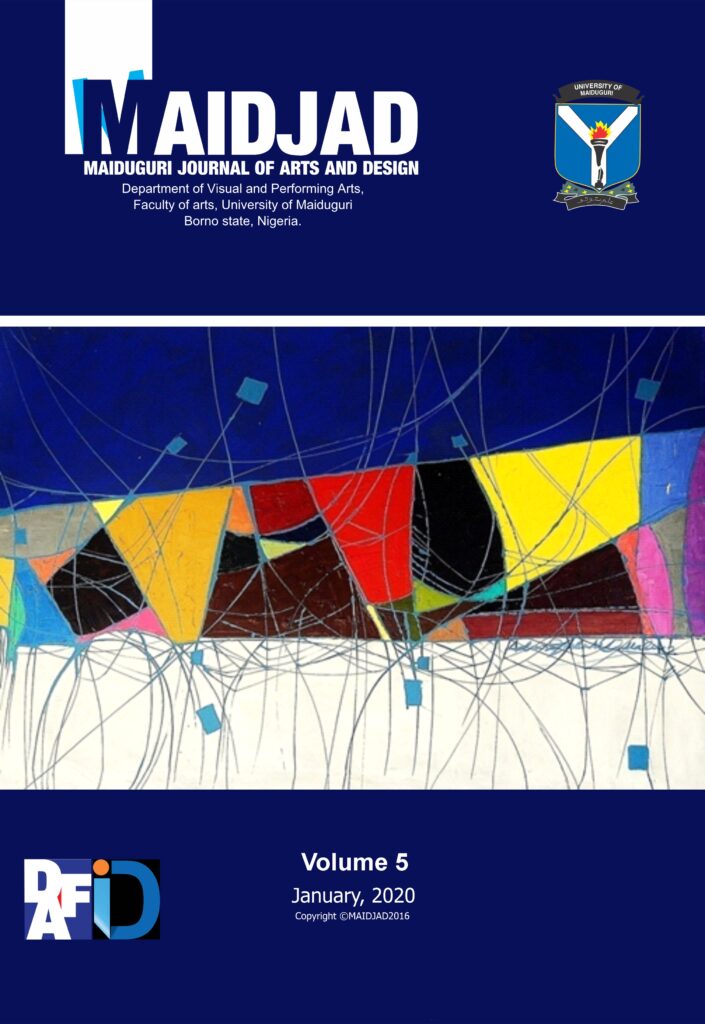
FOREWORD
The editors of MAIDJAD continue to maintain consistency as this edition is published on schedule. A variety of papers are once more drawn from the different disciplines of the arts, like in the previous editions. It appears the central concern in this edition is “recycling”, particularly of plastics.
There may be no act to find a journal’s construction on face value but, as was the observation in the previous edition, experts in the art industry still shy away from sharing their views on this platform. A new meaning appears to have been given to what a journal is, which is that it is a forum by which younger academics publish papers to obtain promotion. This is why all contributors in this edition, like in the previous one, are located in tertiary institutions and are those who are yet to reach the pinnacle of their carriers. Many artists and designers are actively engaged in art propagation outside these tertiary institutions such as galleries, museums, theatres, troupes and industries. Their experiences at their jobs would certainly add invaluable knowledge to readers. They need to be attracted to contribute papers. Perhaps MAIDJAD should consider raising funds to organize writing workshops and conferences with the sole purpose of reestablishing the importance of art journals to all art enthusiasts.
This observation is not in any way meant to undermine the quality of papers in this edition. Indeed, I was troubled by the emotions Sunday Gyang’s paper evoked. I saw Kevin Carter’s Pulitzer award winning photograph, “Starving Child and Vulture”, in 1994. I am aware that a lot of money was raised to support Sudan in its fight against famine as a consequence of the photograph’s publication in the New York Times. I am also aware that Carter committed suicide eventually. What I did not know, which was provided by Gyang’s paper, was the point that Carter refused to help the child as directed by his sponsors with the bizarre excuse that he had a plane to catch! How different was his action from that of a National Geographic photographer who refused to interfere while filming an ape in trouble?
Readers will certainly find many papers of interest in this edition.
Professor Jacob JariJanuary, 2020
Get individual articles of all authors below.
THE CONTEMPORARY WOMAN IN A CONSERVATIVE CULTURE: JULIE OKOH’S OUR WIFE FOREVER TO THE RESCUE
Barth OSHIONEBO/ Joseph Tyoakula ANDE
THE PLACE OF FOLLOW-UP IN COMMUNITY BASED THEATRE: AN EVALUATION OF THE ABU FUNTUA EXPERIENCE
ABODUNRIN, Olusegun / AKOH, Jimmy
THE MILK MAID IN PERSPECTIVE: A FORMAL ANALYSIS OF SELECTED FULANI MAIDEN INSPIRED ART WORKS
Kennette Dikens NWABUOKU
USING GRAPHIC COMMUNICATION SOLUTIONS IN ADDRESSING IMPACT OF CLIMATE CHANGE
GYANG Sunday S.
APPLICATION OF SINGLE FIRING TECHNIQUE FOR EFFICIENCY IN FUEL AND TIME
Ezra ABUBAKAR/Helga MATHIAS
AN ASSESSMENT OF NATURE IN CONTEMPORARY VISUAL ART
DAUDA Alabi Usman / ANTHONY Eleh
SCULPTURE AND ADAPTATION; EFFECTIVE FORMS IN ALLO
ASOGWA Ifeanyichiukwu Fidelis
ADENLE John Oyewole / ARUEYINGHO, Geoffrey Ajemijoye
AN EXAMINATION OF ANTHROPOMORPHIC TERRACOTTA SCULPTURES FROM THE NOK CULTURE.
AGADA, Ladi Onyi Andrea / BOYI, John Mallam
MATHIAS Helga / ABUBAKAR Ezra / ABDU Sheikh Ubale
PALNAM Ijudai Musa / AZI J. I.
SALAWU Nanahawa
ART PRENEURSHIP IN WASTE REPURPOSING: AN EXPERIMENT WITH PLASTIC WASTES FOR PAVING STONES
ADENLE John Oyewole
THE ROLE OF PRODUCTION MANAGEMENT AND ITS FUNCTIONS IN THEORY AND PRACTICE OF INDUSTRIAL DESIGN
PALNAM Ijudai Musa / HASHIM Muhammad Bashir and PAUL James Oche
THE DYNAMICS OF VISUAL ARTS IN THE DEVELOPMENT OF CHANGE AGENDA IN A DWINDLING ECONOMY
IZOGIE Collins Ogieva / DIKENS Nwabuoku Kennette
CERAMIC STUDIO PRACTICE IN NIGERIA: A POTENTIAL ENTREPRENEURSHIP DEVELOPMENT.
SATSI Stephanie Gyenom
EMOTIONAL ELEMENTS IN PRODUCT BRANDING AND THE ROLE OF SELF-CONCEPT: A CASE OF APPLE
HARUNA Naomi Andrew / SYLVA Christine
PRACTICE-LED AND PRACTICE-BASED RESEARCHES
ADIWU Talatu Onkala / Professor MBAHI A. A.